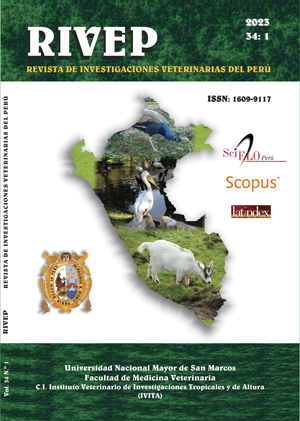Use and effectiveness of virtual learning environments in the academic performance of veterinary students
DOI:
https://doi.org/10.15381/rivep.v34i1.24613Keywords:
virtual environments, learning, academic performance, veterinary educationAbstract
The aim of this study was to determine the use and effectiveness of virtual learning environments (EVA) in the academic performance of Veterinary Medicine students at the Pedro Ruiz Gallo National University (UNPRG), Chiclayo, Peru. The study included 192 students from the first to the tenth cycle, enrolled in nine generic, specific and specialty training subjects. A questionnaire of 39 questions with Likert-type responses of four ratings was applied to them. Cronbach's alpha was 0.937 for the level of use and 0.912 for the effectiveness of the VLEs (Virtual Learning Environment). The assessment of academic performance was carried out from the grades obtained under the vigesimal system. Most of the students were in moderate agreement in all the dimensions of use, except in the intention of use. Likewise, those from 16 to 20 years of age located in the I to IV cycle had a low level of use (p<0.01), while those over 20 years of age located up to the X cycle and both men and women had a regular level (p<0.01). In the effectiveness, the majority disagreed with the online studies, considering the nature of the career, the resources used and the activities to be carried out and moderately in agreement with the design of communication and didactics. On the other hand, the levels of effectiveness were similar to those of use. Academic performance was regular considering age, study cycle and sex (p<0.01 for sex). The relationship between academic performance with the level of use and effectiveness was X2=0.27 (p>0.05) and X2=0.57 (p>0.05), respectively. The indicators of intention to use, activities to be carried out, resources used, didactics and nature of the degree program became critical factors of the educational task in a virtual environment.
Downloads
Downloads
Published
Issue
Section
License
Copyright (c) 2023 Gloria Vásquez Sánchez, Eduar Vásquez Sánchez, Iván Salvador Briceño, Edgar Vásquez Sánchez, Jorge Guevara Vásquez, Gloria Salvador Vásquez

This work is licensed under a Creative Commons Attribution 4.0 International License.
AUTHORS RETAIN THEIR RIGHTS:
a. Authors retain their trade mark rights and patent, and also on any process or procedure described in the article.
b. Authors retain their right to share, copy, distribute, perform and publicly communicate their article (eg, to place their article in an institutional repository or publish it in a book), with an acknowledgment of its initial publication in the Revista de Investigaciones Veterinarias del Perú (RIVEP).
c. Authors retain theirs right to make a subsequent publication of their work, to use the article or any part thereof (eg a compilation of his papers, lecture notes, thesis, or a book), always indicating the source of publication (the originator of the work, journal, volume, number and date).










